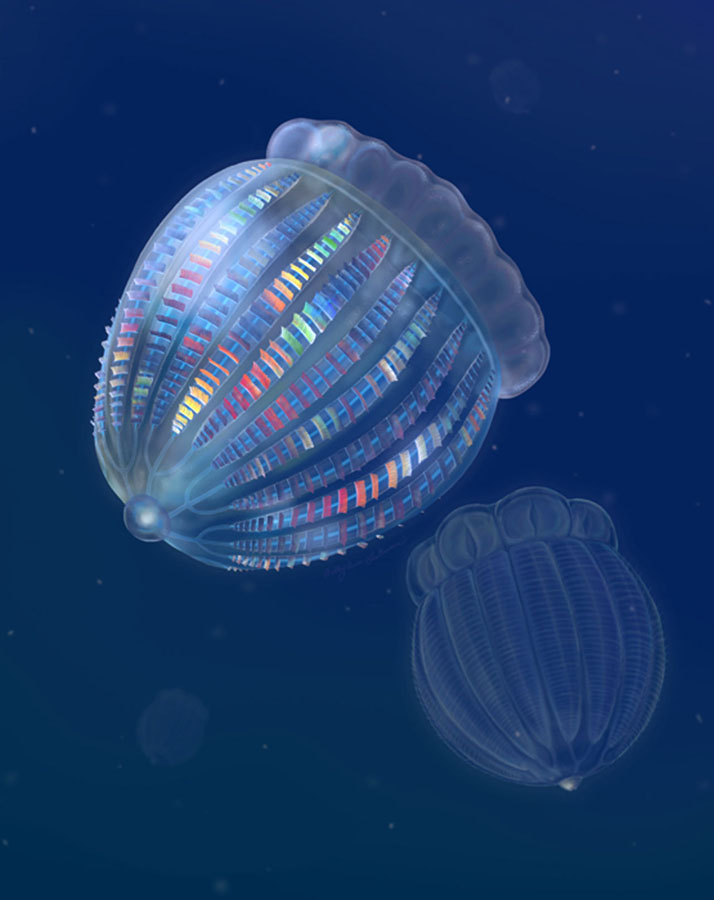Cambrian Comb Jellies Had More Complex Neuroanatomy than Living Species

Paleontologists have described two new species from the Cambrian period of Utah, which illuminate the early evolution of nervous and sensory features in ctenophores (comb jellies).
Ctenophores are a group of over 200 living species with a transparent gelatinous body superficially resembling that of a jellyfish.
While some studies suggest they might represent the earliest branching animals, others suggest a more traditional position as close relatives of jellyfish.
The two new species, named Ctenorhabdotus campanelliformis and Thalassostaphylos elegans, are a spectacular addition to the scant fossil record of the group.
The specimens were found in the Marjum Formation in the House Range of Utah, and represent the first ctenophore fossils ever discovered in the United States.
Ctenorhabdotus campanelliformis had a small bell-shaped body with up to 24 comb rows and a wavy mouth opening.
Intriguingly, this species had two important features: (i) a rigid capsule that protected the sensory apical organ, and (ii) a well-preserved nervous system; the nerves are long, and connect with a ring around the mouth.
“This was quite an unexpected finding, as only one species (Euplokamis) of comb jellies today has comparable long nerves,” said Professor Javier Ortega-Hernández, a paleontologist in the Department of Organismic and Evolutionary Biology at Harvard University.
“Most modern comb jellies have a diffuse nervous net, and not well-defined long nerves.”
Thalassostaphylos elegans had a rounder appearance, approximately 16 comb rows, and a wavy mouth opening.
It had an important feature known as the ‘polar fields,’ which can be seen as two small dots on top of the apical organ.
“These are also important for sensing the environment in living comb jellies, and finding evidence for them in the Cambrian is significant for understanding their evolution,” Professor Ortega-Hernández said.
“Interestingly, Thalassostaphylos elegans does not have a rigid capsule, indicating that the skeleton found in early Cambrian ctenophores was already lost in some representatives by the mid-Cambrian.”
Professor Ortega-Hernández and colleagues concluded that Cambrian ctenophores had more complex nervous systems compared to those observed today.
They also performed phylogenetic analysis which suggests the condensed nervous system is actually the ancestral condition and that only modern ctenophores have lost this complex nervous system and instead favored a more diffuse nerve net.
“This discovery means that there has a been a secondary simplification of comb jellies during their evolution, first losing the rigid skeleton, and then the discrete nerves observed in the fossils,” said Dr. Luke Parry, a paleontologist in the Department of Earth Sciences at the University of Oxford.
“These are insights that would be impossible to obtain from only studying living comb jellies, so the fossil record is providing a valuable glimpse into the evolution of these enigmatic animals.”
“In this context, Euplokamis would be showing a sort of vestigial organization of the nervous system, which are not seen in other living ctenophores,” Professor Ortega-Hernández said.
“Ctenophores have a more complex evolutionary history than what can be reconstructed from their living representatives alone.”
“Fossils allow us to understand the morphology that developed first and how it has changed through time.”
The discovery is reported in a paper published in the journal iScience.
_____
Luke A. Parry et al. Cambrian comb jellies from Utah illuminate the early evolution of nervous and sensory systems in ctenophores. iScience, published online August 4, 2021; doi: 10.1016/j.isci.2021.102943
Source: www.sci-news.com/








